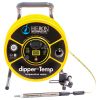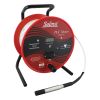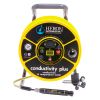Solinst Model 201 Water Level Temperature Meters
Features
- Accurately measure temperature from -20ºC to +125ºC
- Corrosion and chemical-resistant PVDF flat tape
- Standard 9V alkaline battery gives 90 hours of use
- Free ground shipping
- Expedited repair and warranty service
- Lifetime technical support
- More
Overview
The Model 201 Water Level Temperature (WLT) Meter is ideal for measuring static water levels, as well as profiling temperature in wells, boreholes, tanks and open water. Accurate temperature measurements are clearly displayed on an LCD readout on the faceplate, from -20ºC to +125ºC. Water level and probe depth measurements are read off the Solinst durable PVDF flat tape. Tape lengths are available up to 1000 ft (300m).
High-Quality Materials
The 201 Probe is made of high quality 316 stainless steel. The pressure-proof probe can be submerged to 1000 ft (300m). The zero measurement point on the probe is close to the tip, keeping water displacement at a minimum. The temperature sensor is located at the stainless steel tip of the probe, however, since the probe body acts as a heat sink, best accuracy is obtained when the probe is completely submerged. The tape seal plug design allows the probe to be easily replaced, if required.
The WLT Meter uses extremely durable PVDF flat tape. The tape is non-stretch and has a dog bone design that prevents adherence to wet surfaces. The tape reels smoothly, remains flexible and hangs straight, regardless of temperature. It is also easy to repair and splice. The 3/8" (10mm) wide tape has permanent laser markings every 1/100 ft. or each millimeter, traceable to NIST and EU measurement standards.
Operation
When the meter is turned on, the LCD screen displays the firmware version of the WLT Meter (e.g. “WLTM 1.0”) for about two seconds. The LCD will then display the temperature reading, in or out of water. The LCD menu is simple to operate. Pressing the button two times quickly deactivates the buzzer (the light stays active). To reactivate, press the button two times quickly. To turn the meter off, press and hold the button for two seconds.
When the zero point of the 201 Probe enters water, an electric circuit is completed, activating the buzzer and light. The depth to water is then read off the flat tape. Temperature readings are read off the LCD display. As the probe is lowered to take temperature measurements at discrete depths, the buzzer can be turned off by pressing the button two times quickly. This is ideal when profiling temperature.
In The News
Research in the Reserve: Promoting Interdisciplinary Conservation at the Great Bay National Estuarine Research Reserve
On an early winter day in 1973, a helicopter buzzed over Durham, New Hampshire, just a few miles from the Atlantic Ocean. One of the helicopter’s guests, oil magnate Aristotle Onassis, owner of Olympic Refining, looked east of town and saw what he hoped would become the world’s largest oil refinery. Instead, he saw the Great Bay; thousands of acres of green coastal forest, mud flats, salt marshes, and estuarine tidal waters stretching over the land toward New Hampshire's small Eastern coastline. Onassis likely also saw a group of Durham residents staked out on the bay’s coast, ready for him to pass overhead. While out of place in the natural setting, an obvious message was spelled out in red paper: “Not Here.
Read MoreFloating Global New Ideas: Buoy-Enabled Research at Florida Agricultural and Mechanical University’s School of the Environment
Florida Agricultural and Mechanical University (FAMU), based in Tallahassee, Florida, is the highest-rated public Historically Black College or University in the United States. FAMU’s School of the Environment (FAMU-SOE) offers BS and BA degrees in Environmental Studies, and BS, MS, and Ph.D. degrees in Environmental Science, with specialisms available in areas including Environmental Policy and Risk Management, Aquatic and Terrestrial Ecology, and Biomolecular Sciences. In 2021, FAMU-SOE deployed a NexSens CB-450 buoy in Apalachee Bay, a key oyster farming area around 30 miles south of Tallahassee. The buoy has quickly been incorporated into the curriculum, providing environmental insights for student research, the community, and beyond. Dr.
Read MoreMonitoring Habitat Suitability and Water Quality in Northwest Arkansas Springs
Northwest Arkansas has seen an economic, industrial, and population boom in recent years as a result of expanding businesses, which have created thousands of jobs in the region and the mass migration of employees and construction companies. However, with this growth has come rapid urbanization and the degradation of the natural landscape, specifically the freshwater springs that can be found throughout the region. These springs are critical habitat centers for native wildlife, home to threatened and endangered fish, and those that have yet to be listed. Zach Moran, Assistant Professor of Fisheries Science at Arkansas Technical University, is working to help monitor these habitats and provide key data that will hopefully inform future development in the region.
Read More

























